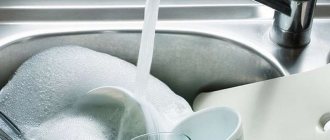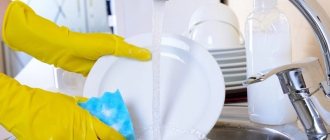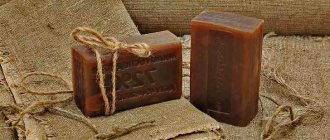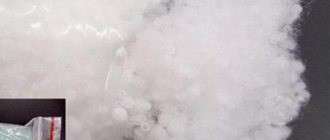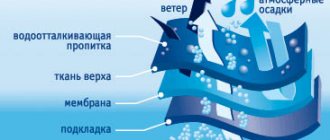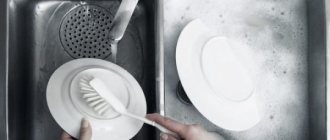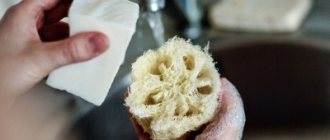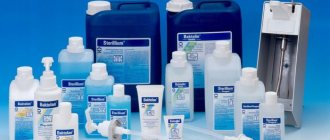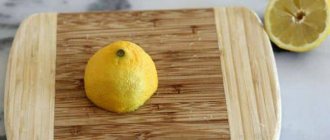What happens if you put hand washing powder into the washing machine?
“If you put hand washing powder into the machine, then during the washing process the foam from the machine will creep onto the floor. Due to constant shaking, the manual powder will produce such an amount of foam that it simply will not fit into the machine and will crawl out everywhere possible.
Interesting materials:
Do I need to lace up the review and suggestion book? Do I need to putty before painting my car? Do I need to wash off Deltsid? Do I need to remove paint before plastering? Is it necessary to remove the film from mushrooms? Do I need to remove the packaging from the bouquet? Should you mow your clover lawn? Do I need to remove old wallpaper? Do you need to study to become a designer? Do I need to cover strawberries?
Natural laundry and cleaning products.
People often ask what to wash clothes with, what to wash dishes with? I experimented for a long time and found a universal remedy. A cheap remedy.
Attention, this is SODA!
Soda for everything: I wash dishes with it, it squeaks after washing like that. Baking soda does not scratch the surface of the dishes. It is absolutely harmless to the OS. For soil, for example. If you wash dishes in the country, then baking soda is even good for the earth! I washed the bathtub with Domestos and other modern cleaning products for a long time. Sound familiar? And to achieve results, it was necessary to work hard. When I first started cleaning the bathtub with soda, I thought that now I would be tired of working with my hands. Nothing like that, soda seems to corrode all the dirt! It now takes me less time to clean the bathtub than before! I also use natural sponges. I sewed it from terry fabric measuring 12 by 12 cm in two layers. Previously, I used regular sponges, where one side is rough. It was this side that was needed to wipe off the dirt. But always, throwing out another sponge, it was a pity to litter nature. Now I use 100% cotton terry sponges, which are machine washable as needed. And soda acts as a rough layer))))
Wash
: Washing is very easy.
At first I washed with soap nuts, but they stain light-colored clothes... brownish... I had to look for another product. Thanks to common sense and smart people, I realized that modern eco-products are nothing more than ordinary chemical detergents for washing and washing, only in lower concentrations. For example, such well-known products as Ecover, Amway, contain chemical and carcinogenic (!!!) substances. We read the labels: you don’t even have to go far, it contains surfactants.
What are peahens?
These are synthetic compounds. Synthetic, i.e. chemical. What is chemistry? That's right - this is not natural at all. Next: preservatives, fragrance
. Hm. Do you smell that smell of deception? They sniffed us an old chemical powder, only in less concentration.
Someone will say quite truthfully: “They created a tragedy, in eco-products, the concentration of chemistry is minimal! My mother waters flowers with water from this product!”
And here is the first mistake: any chemistry (I will even emphasize) - any chemistry does not have the ability to be eliminated from the body, it can, of course, be eliminated, but not all of it, and not at once. Chemistry ACCUMULATES in the body. And if you water your flowers and they still grow. Just wait a while: they are still growing, until
... If you continue to water them in the same spirit, they will die. Do you need experiments? Why, look around, you already install them every day!
Mistake two: chemistry in lower concentrations does not cease to be chemistry! The chemical gets on the fabric (washing powder), it is not washed or rinsed. It enters the soil with water. It doesn't decompose. It accumulates and kills living things. I am already silent that with things, in contact with the body, it enters the cell membrane (under the skin, in other words) and continues to act there. Again, unless you suffer from eczema, the accumulation threshold has simply not yet reached the desired concentration. Do we have many allergies? What about 100 years ago? How about 150? The concept of allergy did not exist then! Allergies were born with the development of chemistry.
So, if there is only poison all around the universal conspiracy, what to wash it with?
I found my universal remedy: I put 2 tsp directly into the drum for washing. soda All. If you wash cotton, after a few washes you will be pleasantly surprised: cotton smells like cotton! Remember that divine smell of fresh organic cotton purchased? So, the smell of your old cotton clothes will come close in this!
If I wash white clothes:
I put 2 tsp. soda + 1/3 lemon. I cut off the lemon, straight with the skin. I put it in a washing net and wash it at high temperature. After washing, the laundry smells like a subtle, wonderful scent of lemon. We throw out the skin and cake from the mesh. Lemon has a pronounced whitening effect. Removes stains well.
For washing wool
I use laundry soap. But no additives. Regular natural dark soap with a distinct scent. I revived the natural wool that I had left over from the older one and had already turned yellow/gray and stained. We rub the wool well with soap, we are not afraid, in three places of contamination (I even scrub Dizanov wool, who knows, this is a very capricious wool), then we squeeze the whole thing with our hands and rinse. Until the water turns from white to clear. All! My natural woolen items have become perfectly clean! All stains, even old ones, have disappeared!
You can, of course, use many other natural remedies (mustard, bread crusts, etc.). But this method suited me perfectly.
Important: it is absolutely harmless! It's very economical! You all know, yes, how much does a bag of soda and household soap cost? So there is a healthy alternative, and, in my opinion, stop using advertised products. They are never eco. Eco is what gives life, brings us back to life! Go natural!
Aspirin for whitening
Store-bought bleaches contain chlorine, are aggressive and weaken the material of clothing. Aspirin is milder. Salicylic acid in its composition destroys dirt, but does not damage fabric fibers.
Grind 5 aspirin tablets and add to laundry detergent when washing. This will rid white items of grayness and yellow spots.
For old and stubborn stains, use soaking.
- Crush 8-10 aspirin tablets.
- Dissolve in 9-10 liters of cool water.
- Soak the laundry for at least 7 hours. Or leave it overnight.
- Place the items in the washing machine and wash.
The expiration date of aspirin is only important when taken orally. Use expired aspirin when washing, the effect will not decrease.
Hand wash in a ziplock bag
Bed linen cannot be washed this way. But T-shirts, shorts, socks and baby clothes are easy.
- Take a bag and place your clothes in it.
- Add powder.
- Fill with water until it covers things.
- Release the air and fasten the clasp tightly.
- Shake and knead the bag. The process is similar to washing in a machine, only you are the motor.
- After washing, all that remains is to rinse the items in the bag.
The method is suitable for road conditions when there is no washing machine at hand. For example, on a hike, on a long car or train trip. Or to save money on hotel laundry while on vacation. Also in these cases, use shampoo instead of powder. And hair conditioner - instead of rinse aid.
If you don't have a ziplock bag, use a regular one. For strength, insert one into the other. Tie the edges with a knot.
Leave heavily soiled items in the bag for a couple of hours. Knead and stir occasionally.
Using soap and soda solution for washing and cleaning the house without chemicals
Soap and soda are widely used in everyday life, kindergartens, schools for disinfection, washing and cleaning without the use of chemicals. Soap and soda themselves are quite active substances. And when combined, they enhance and complement each other’s action.
To prepare a soap-soda solution, it is best to use laundry soap. It has a simple natural composition without harmful chemical impurities.
Toys and other common items are treated with soap and soda solution. This is especially important during epidemic periods.
The concentration of soap and soda may vary depending on the purpose for which the solution is made.
Depending on the degree of contamination of the room, prepare a one- or two-percent soap-soda solution.
To prepare a one percent soap-soda solution you will need:
- 10 liters of water;
- 100 g laundry soap;
- 100 g soda.
To prepare a two percent solution of soap and soda, take twice as much for the same amount of water. Instead of regular soda, you can use soda ash to wash floors.
What can you do to wash your clothes if you don’t have laundry detergent?
Modern household chemicals have a highly specialized purpose: for washing floors, dishes, and laundry. And it is right. Such products contain additives that increase the effectiveness of fighting dirt in this direction. But basically all detergents are designed for cleaning and can be replaced if necessary.
If necessary, you can replace the washing powder with other household chemicals
Hand washing with household products not intended for this purpose is safer than machine washing; You need to use the machine with caution: increased foaming or the appearance of insoluble sediment on the walls - all this can lead to equipment failure. But hand washing also has its drawbacks: too aggressive substances can cause not only allergic rashes, but also damage to the skin of the hands.
Is it possible to wash clothes with detergent?
Is it possible to find a detergent that will be most effective with minimal risks, Sobesednik.ru found out.
Washing is a task where you can’t do without household chemicals if you want to use decent-looking laundry. At the same time, washing powders are considered one of the main sources of problems in households.
Surfactant Any detergent, including for washing clothes, contains surfactants - surfactants. Otherwise, it would lose the ability to clean anything from dirt. It’s worth knowing about surfactants that they come in different types: for example, anionic ones are more toxic, non-ionic ones are less toxic. The problem is that there are a lot of specific surfactants and often only the manufacturer knows what is in a particular product, what purity it is and in what quantity. Moreover, usually one powder contains both surfactants and others.
Phosphates
Phosphates can also be found in the list of detergent ingredients. These components allow, firstly, to reduce the amount of surfactants, secondly, to reduce water hardness (thereby making washing easier), thirdly, to prevent the appearance of scale in the washing machine, and fourthly, to reduce powder consumption, allowing you to save money. However, now you can also find powders without phosphates. Why, if they make washing easier? Environmentalists have many questions about them. In particular, it is believed that phosphates pollute water bodies, causing them to bloom. Phosphates are not dangerous for humans. However, laundry detergents that do not contain them can be identified by their mention of zeolites.
Zeolites
Zeolites are natural components that have been added to powders as an alternative to phosphates. It's no joke: zeolites are used in the food industry, for example for the production of soft drinks and animal feed. For a time, zeolite laundry detergents were perceived as a panacea and a solution to an environmental problem. But, alas, another problem arose - and even several: it turned out that zeolites accelerate the wear of equipment and things, create dust, and most importantly, they are poorly washed out after washing, thereby increasing the risk of allergic reactions among “users” of linen.
Whitening components
According to toxicologists, bleaches deserve the biggest complaints in the composition of powders. The ones that do the best job of returning white things to their original color. They most often come in two types - optical and oxygen-containing. There are also chlorine-containing ones, but everyone is well aware of their danger to the skin - and they only use it for cleaning plumbing fixtures. They can be washed with optical or oxygen-containing detergents. The former only create the effect of snow-whiteness (in other words, it seems to you that the sheets have become whiter, but in fact they have not), the latter actually bleach, dissolving stains that stain the laundry, and they can even be used for colored items (such bleaches can be identified by sodium percarbonate in composition). Isn't that great? Unfortunately, in both cases there is a problem with leaching out the bleach after washing - optical bleach remains on the laundry and can become an irritant, oxygen bleach leaves it more easily, but still requires several rinses.
About liquids
Laundry detergent is not necessarily a powder. Nowadays there are quite a few liquid analogues on sale, and in some sense they are preferable for delicate items and children's clothing. This, of course, is still the same household chemicals, but it has at least two advantages: first, it does not create dust
and does not irritate the mucous membranes of the respiratory system, the second is easier to wash out.
About rinsing
In the case of washing powders, there is only one way to really minimize possible harm: rinse things. But everyone does it anyway, so what's the problem? The point is that once is not enough. And two too. Experts recommend 4-5 rinse cycles.
About soap
It's the 21st century, but many people still wash with soap - for example, mothers of small children, especially those suffering from atopic dermatitis or allergies. And environmentalists consider this to be completely justified, since this version of the laundry detergent is as gentle as possible (unless, of course, it contains dyes and flavors). Soap, including natural olive soap (it is also available for washing) or baby soap, washes quite well, however, in this case you have to sacrifice the color of white things - after several washes they inevitably turn gray.
About soap nuts
An interesting and popular type of laundry detergent among supporters of the eco-theme is the so-called soap nuts. These are the fruits of a shrub of the Sapindaceae family, which grows in Asia, a traditional laundry detergent, for example, among the peoples of India. You can wash any type of fabric with these nuts, but the result will be the same as with other “natural products”: they may not be able to cope with difficult stains. And the washing machine is not protected by anything during such washing, unlike in those cases when ordinary modern washing powder is used.
By the way
The powder is being recalled from the market. Why?
Sometimes it happens that sanitary services recall some type of household chemicals, including washing powder. What does it mean? What was revealed during the inspection: the product does not meet the requirements. There are many indicators that are assessed during such checks, but mainly the overall toxicity of the product is assessed - in order to sort out the details, you need to know what exactly to look for. Most often, a product is “rejected” based on its toxicity index. Why does such a product even come to market? Unfortunately, it often happens that a sample passes all the standards during the initial examination, and then the manufacturer switches to cheaper components, due to which toxicity increases.
What is the difference between machine washable down jackets?
Their packaging or instructions contain information about the use of down jackets made from natural or artificial filler.
High-quality liquid detergents have the following effects
- do not clog the internal filling and external material;
- are completely washed off without leaving streaks;
- do not contribute to the formation of fluff (feathers) inside the compartments;
- do not wash off the top layer of feather fat;
- remove stains and odors;
- do not reduce color brightness.
Jackets-overalls with natural fillings for active sports, manufacturers often equip the top layer with a membrane. In this case, choose the names of down jackets with the words “for membrane”, “for sportswear”.
There are professional machines for cleaning down products in the form of:
- liquid of varying consistency and concentration (gel, lotion, shampoo);
- individual capsules in the form of bags filled with a liquid substance.
Powder for powders is practically not used, since it is poorly washed out, clogging the material. In emergency situations, use a dry formulation suitable for delicate washing (e.g. Ariel, Persil, Test lines) or children's clothing (Earsome Nanny). After cleaning, rinsing should be repeated 2-3 times.
How to choose the right detergent composition
Select the appropriate mixture for your down product from a consultant in a sports store (the same “Sportmaster”). or in the specialized department “Household Chemicals”.
When choosing a detergent for washing a down jacket, you need to remember additional criteria:
- color of the product - bleaches in the composition are allowed only for white surfaces;
- the presence of a membrane - the coating requires a special product that has a mark on the cleaning of down and feathers;
- Frequency of use - when washing more than 2-3 times a year, choose a 0.75 liter capacity or economical capacity.
Bleach (from Flat, Amway), suitable for delicate washing, can only be used in cases of very heavy soiling. If you do this, reduce the recommended amount by half.
How not to wash down jackets
To preserve the properties and appearance of down jackets, do not use the following detergents and other substances:
- regular washing powder or soap;
- bleaches;
- air conditioners;
- rinse aids;
- multifunctional fluids (contain additives of the following categories).
Such substances wash away the natural feather coating, and the filling does not dry out or become lumpy. Strong concentrates damage the insulation of internal and external materials, discolor items and leave a strong odor. If you want to soften your clothes during the wash, buy a special down product from GBM Acquapiuma. Add it during the final rinse as directed. In addition to its antibacterial effect, the conditioner does not stick to down and feathers.
What can replace a professional product?
In addition to a soft, dry or liquid substance designed to gently wash children's clothing, there are several cleaning alternatives:
- soda-based powder without increased foam;
- sulfate-free hair shampoo;
- shampoo for washing cats and dogs;
- an aqueous solution of water and laundry soap (with the addition of 1 tablespoon of vinegar, ½ tablespoon of baking soda, 2-3 drops of ammonia);
- soap nut solution (only for white things);
- Dishwashing liquid (to remove greasy and dried stains).
The shampoo and baking soda are machine washable, but the rest can only be hand washed. To prevent alternatives from stripping away the natural finish, add 1-1.5 teaspoons of baking soda to water solutions.
Salt when washing brightly colored items
Salt is added for the following reasons:
- Things fade when washed. Soak clothes before washing in saline solution - 1 tbsp. l. for 1 liter of water. Or just add 1 tbsp when washing. l. salt into the drum of the washing machine.
- To keep things bright. Even if the item does not fade, over time it will lose its bright colors. Add salt when washing to prevent your clothes from becoming dull.
- To restore the color of things. In this case, you need to add salt to the rinse aid compartment. After washing, the clothes will become brighter.
All these methods do not take much time and save money on buying household chemicals and new clothes. Use our tips, and your favorite things will serve you much longer.
- Author: iarriba
Rate this article:
- 5
- 4
- 3
- 2
- 1
(3 votes, average: 5 out of 5)
Share with your friends!
Citric acid for cleaning and washing without harm to health
This substance can be used not only for cooking, but also for washing and cleaning without the use of harmful chemicals.
Citric acid helps to easily remove scale from the inside of an electric kettle. Scale spoils the appearance of transparent glass or plastic teapots. If the kettle is opaque and the scale is not visible, this does not mean that there is no need to deal with the scale. Scale spoils the quality of boiled water and reduces the service life of the kettle.
To descale a kettle, just pour 20-30 g of citric acid into water and boil. Then leave to act for 15 minutes, drain and boil clean water in a kettle. This water should also be thrown away.
By pouring water with citric acid from the kettle into the sink, you further clean the drain pipe.
Citric acid is good at removing scale that is deposited on the parts of the washing machine. If you do not remove scale regularly, the washing machine quickly breaks down, requires replacement of parts, or becomes completely unusable.
Experienced washing machine repair technicians recommend abandoning popular chemical descalers in washing machines in favor of regular food-grade citric acid.
This remedy is much more effective and much cheaper.
Sweat Stains: Lemon Juice and Baking Soda
Use to remove yellow sweat and deodorant stains from white clothing.
- Squeeze the juice from the lemon and mix with soda in a 1:1 ratio.
- Apply to the stain and leave for 15 minutes.
- Wash the item as usual.
Use citric acid instead of lemon. To do this, dissolve 1 tsp in a glass of warm water. acids. Baking soda not only removes stains, but also odors.
The method is not suitable for old contaminants. Check the armpits of light-colored items after 1-2 wears. If stains appear, get rid of them immediately, do not put it off “for later.”
Do not use lemon juice on:
- wool;
- silk;
- lace.
Acid will destroy fabric fibers and ruin the appearance of the product.
If lemon and baking soda do not remove the stain, use another mixture. Mix baking soda, dish soap and hydrogen peroxide in a ratio of 2 tbsp. l. : 4 tbsp. l. : 1 tsp. Dampen the cloth, apply the product, leave for 15 minutes. Rub and then wash as usual.
Washing sports shoes
Rules for washing sports shoes:
- Rinse sneakers and trainers by hand first. Using a thin stick or knitting needle, remove pebbles from the protectors.
- Secure your shoes by tying the laces together.
- Wash in a bag or old pillowcase. Add an old towel to your shoes. This will reduce the beating on the glass of the drum and on the insides - ribs, blades.
- Wash at 30-40 degrees, no more than 2 pairs at a time.
Shoes with white soles require more attention. After washing in the machine, scrub the sole with a melamine sponge. It works like an eraser, collects dirt on itself and wears out. Divide it into several pieces. And treat each subsequent area with a clean sponge.
